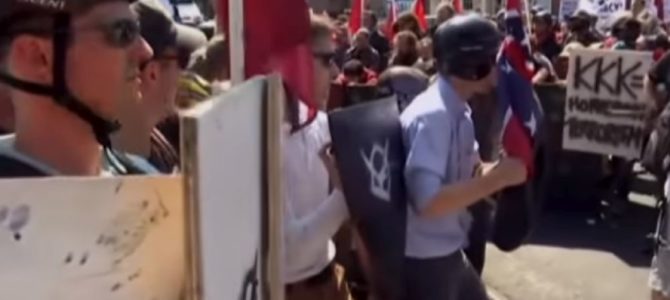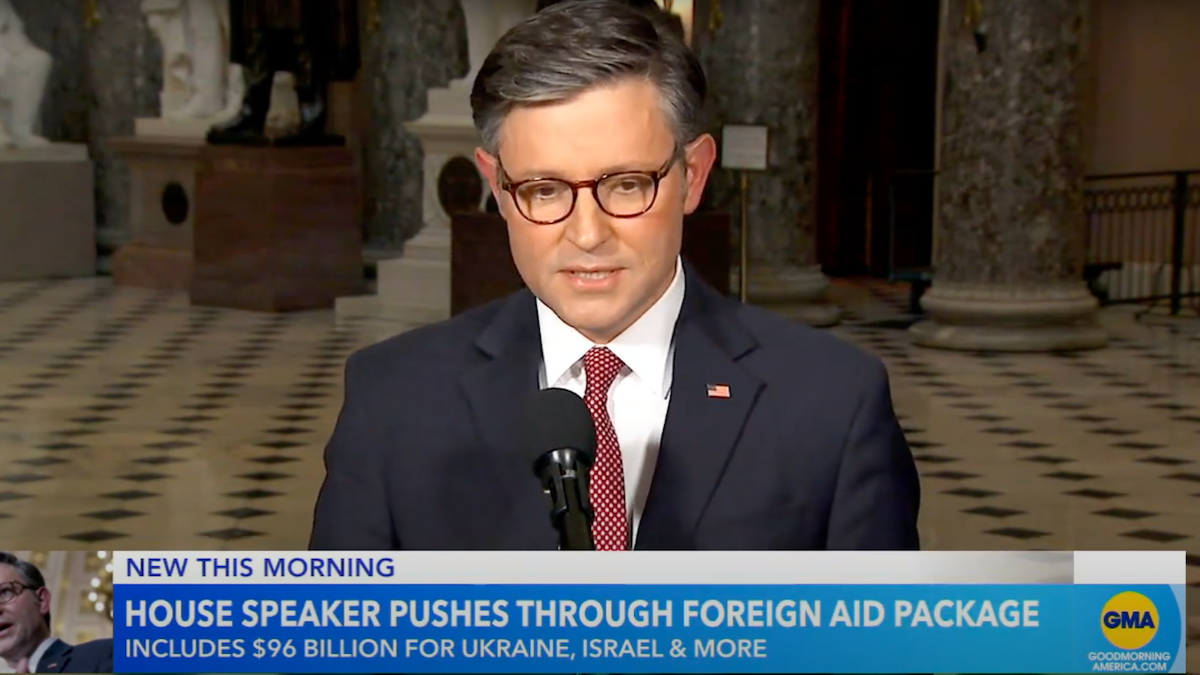
The violence in Charlottesville reveals not who we are as Americans, but who we might become if we allow radicalism and totalitarianism to become normalized. In America today, that possibility is most likely to come, not from the radical Right, but from the Left.
To understand this trajectory, we need to know who the players were in this weekend’s violence. Those behind the protest and the counter-protest were not average Americans, but two extremist groups: anti-fascists (Antifas) on the Left (the counter-protestors) and white supremacist nationalists on the Right (the protesters).
These groups did not suddenly appear with the inauguration of Donald Trump. They’ve been around for a very long time. As Peter Beinart explains at The Atlantic:
Antifa traces its roots to the 1920s and ’30s, when militant leftists battled fascists in the streets of Germany, Italy, and Spain. When fascism withered after World War II, antifa did too. But in the ’70s and ’80s, neo-Nazi skinheads began to infiltrate Britain’s punk scene. After the Berlin Wall fell, neo-Nazism also gained prominence in Germany. In response, a cadre of young leftists, including many anarchists and punk fans, revived the tradition of street-level antifascism.
In the late ’80s, left-wing punk fans in the United States began following suit, though they initially called their groups Anti-Racist Action, on the theory that Americans would be more familiar with fighting racism than fascism. According to Mark Bray, the author of the forthcoming Antifa: The Anti-Fascist Handbook, these activists toured with popular alternative bands in the ’90s, trying to ensure that neo-Nazis did not recruit their fans. In 2002, they disrupted a speech by the head of the World Church of the Creator, a white-supremacist group in Pennsylvania; 25 people were arrested in the resulting brawl.
By the 2000s, as the internet facilitated more transatlantic dialogue, some American activists had adopted the name antifa. But even on the militant left, the movement didn’t occupy the spotlight. To most left-wing activists during the Clinton, Bush, and Obama years, deregulated global capitalism seemed like a greater threat than fascism.
As Beinart mentioned, in 2002, these two groups violently clashed in York, Pennsylvania, with a street brawl that led to the arrest of 25 people, all of them Antifa except two. “The scene was right out of the former East Germany, perhaps, or any of the hundreds of other European venues where ‘antifas’ (anti-fascists) and neo-Nazis have battled it out with clubs, knives and Molotov cocktails,” one report stated. Afterward, the city of 40,000 residents was “left in shock.”
The Yin and Yang of Political Street Brawls
The conflict between anti-fascists and fascists has been simmering for decades as they’ve been firing shots at each other and gathering recruits or engaging in a war of words on the Internet. The rise of Barack Obama pacified the radical Left to some degree, as much of the conflict during his presidency involved Occupy Wall Street and the anti-capitalist gang. But Antifa remained in waiting, finding cover under the broader progressive ideology of the Democratic Party that indirectly supports its totalitarian agenda and tolerates its violence.
With the contentious campaign and election of Donald Trump, Antifa exploded onto the scene, along with its counterpart, the neo-Nazis. The radical Right—a tiny but despicable group—saw in Trump’s America First agenda an opportunity for legitimization.
Despite Trump and his supporters condemning racism, the Left characterized everyone who supported him as “the radical Right.” Loose and even unwanted associations were seen as blood alliances. Never mind that grandma, who wants better border control and loves Trump because he stands for American interests, has nothing to do with a neo-Nazi thug. She and everyone wearing a MAGA red hat have been deemed white supremacists and racists by the Left.
The result of Trump’s rise has been a flood of anarcho-activists joining the secret ranks of Antifa to silence these legions of so-called neo-Nazis who showed up at Trump rallies. “On Inauguration Day, a masked activist punched the white-supremacist leader Richard Spencer,” Beinart writes. “In February, protesters violently disrupted UC Berkeley’s plans to host a speech by Milo Yiannopoulos, a former Breitbart.com editor. In March, protesters pushed and shoved the controversial conservative political scientist Charles Murray when he spoke at Middlebury College, in Vermont.”
A brawl broke out in New York City on May Day when Antifas clashed with Trump supporters in Times Square. Antifa also participated in the violence at a Trump rally in San Jose, California. The pro-Antifa journal It’s Going Down celebrated the attacks on Trump supporters as “righteous beatings.”
An antifa member is reported saying violence is justified because “resistance is not always safe and pretty, but it is immaculate compared to our monstrous government.” Anyone they determine to be “a fascist, Alt Right, White Nationalist, etc., based on which groups they are a part of and endorse” is targeted.
“Nazis, fascists, white nationalists, anti-Semites and Islamophobes are specific categories, even if they overlap or are subsets or each other. Our main focus is on groups and individuals which endorse, or work directly in alliance with, white supremacists and white separatists. We try to be very clear and precise with how we use these terms.”
Using ‘Racist’ As A Weapon
Antifa’s violence is closely connected to leftist labeling of Republicans—an important point politicians, thought leaders, and the media need to take seriously. Going back to the 1960s when conservatives were called Nazis for supporting law and order, the label of racist has been a club Democrats have used to beat Republicans into submission. If you’re for border control, you’re a racist. If you oppose affirmative action, you’re a racist. If you want greater opposition to radical Islam, you’re a racist. If you don’t believe there’s institutionalized racism in America, you’re a racist. Basically, if you don’t agree with Democrats, you’re a racist.
This is the climate into which Trump stepped when he ran for president. He pushed against it. He was labeled a racist. His supporters were labeled racists. Of course, lurking there in the shadows were the real racists—the white supremacists—who were happy to have anyone speaking out for national interests and cultural protectionism. They glommed onto Trump and claimed him as their own. Trump, however, denounced the Klu Klux Klan and has rejected racism in all its forms. Mostly, he has ignored the radical right, much as Hillary Clinton ignored the radical leftists who supported her. But the label of racist has stuck.
The narrative that Trump and his supporters are racists has been perpetuated by Democrats—and they’re good at it because they were writing that narrative long before Trump came onto the scene. It has been pushed on social media by leftists and repeated by politicians who stoke the flames of perceived racial inequality, labeling everyone who disagrees with them a racist. Worst, NeverTrump Republicans have indirectly joined with these groups by parroting them in their labeling of Trump and his supporters.
This narrative has been amplified with the Charlottesville clash. Now, everywhere you turn someone on the Right is being accused of racism. Those who don’t characterize the violence the Charlottesville according to the Left’s narrative are racists. All groups who stand for constitutional principles are racists. The National Rifle Association is racist. The entire GOP is racist. Any writer who criticizes Black Lives Matter for its violence is racist. The impression is that racists are everywhere; whites are oppressing blacks; Trump is a danger!
What About the Other Side of the Mob?
Yet we’ve been hearing very little about the violent anti-fascists the Left has tolerated and even encouraged. We hear complaints about Trump giving a nod to the radical Right, but we hear precious little about Democrats, liberals, and the mainstream Left giving not only a nod but a nudge to the violent radical Left.
“When the masked antifa activist was filmed assaulting Spencer on Inauguration Day, another piece in The Nation described his punch as an act of ‘kinetic beauty,’ Beinart wrote. “Slate ran an approving article about a humorous piano ballad that glorified the assault. Twitter was inundated with viral versions of the video set to different songs, prompting the former Obama speechwriter Jon Favreau to tweet, ‘I don’t care how many different songs you set Richard Spencer being punched to, I’ll laugh at every one.’”
Violence against Republicans and anyone deemed a “racist” by the Left has gone mainstream. Now, with actual racists showing up and violence ensuing, Antifa and its supporters in the Democratic Party feel even more justified attacking everyone they’ve judged as a fascist, and many in America are tolerating it or at least deflecting blame onto Republicans.
Fueling this are liberals who have been infecting America with the idea that our country is intrinsically racist—a notion Obama perpetuated. It’s in our DNA, he said. We are racist even if we don’t know we’re racist. We’re not judged by our actions or personal guilt, but by those who have determined our collective guilt because of past injustices, our conservative beliefs, politics, and associations. We are the real danger, not anti-fascists who are actually engaging in violence in their ongoing war with the radical Right.
Will the Real Racist Please Stand Up?
After decades of labeling anyone who disagrees with the Democratic Party as racist or fascist, many Americans no longer know what real racism looks like. What happens when you think anyone who supports the president and his policies is a racist? What happens when racists are now being seen as a “domestic threat”?
Sen. Ted Cruz announced that the Justice Department should investigate the violence in Charlottesville as domestic terrorism. He mentioned the neo-Nazis, but nothing about the anti-fascists. Only the racists are considered a threat. But “racists” are now anyone who simply wants to build a wall and put America first on the global stage. Isn’t it possible that in this hostile climate, these common, everyday Americans could be branded a domestic threat while the real danger is being purposely ignored? This might not happen today, but it’s possible if a politician who believes the rhetoric of the Left comes into power.
America’s leaders are giving legitimacy to Antifa by downplaying or dismissing its role in the violence. Republicans who ignore the anti-fascists and the labeling they and liberals employ are once again playing the useful idiots because they want to distance themselves from actual racists and escape the label themselves.
Democrats are ignoring them because they fundamentally agree with Antifa’s ideology, if not their tactics. They want to see conservatives, Republicans, and our nation’s principles of liberty destroyed. If that means unleashing the demons of the radical Left or at least downplaying their violence, then so be it.








